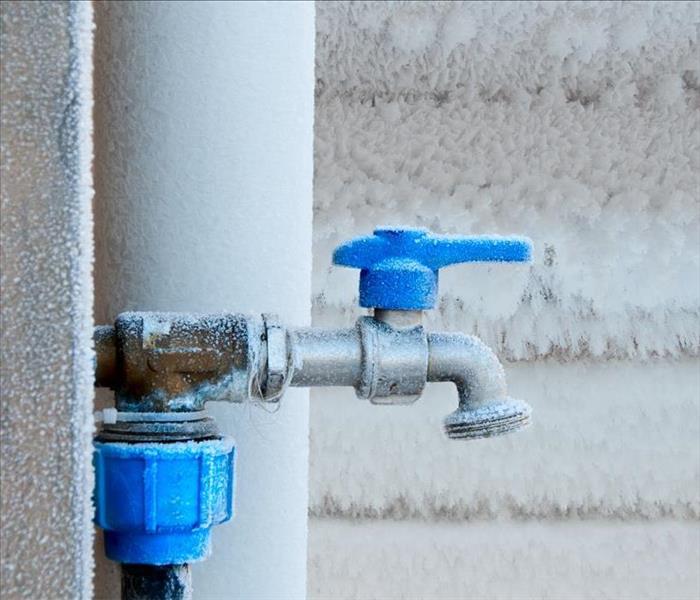6 Steps to Prevent Frozen Pipes in North Central Colorado Springs, CO.
12/26/2023 (Permalink)
Winter in Colorado Springs, CO brings with it a magical snowy landscape, cozy fires, and the holiday spirit. However, it also ushers in freezing temperatures that can wreak havoc on your home's plumbing. One of the most common and potentially costly issues during this season is frozen pipes. When temperatures plummet, the water inside pipes can freeze, leading to cracks, bursts, and extensive damage. To help you fortify your home against the winter chill, we've compiled a comprehensive guide with six effective strategies to prevent your pipes from freezing in Colorado Springs.
6 Strategies to Prevent Frozen Pipes
1. Insulate:
Proper insulation is the first line of defense against frozen pipes. In a region where winter temperatures can be particularly harsh, it's crucial to ensure that all exposed pipes are well-insulated. Start by identifying pipes in vulnerable areas such as attics, basements, and crawl spaces. Foam pipe insulation is a cost-effective and efficient solution, wrapping around pipes to provide a protective barrier against the cold. Additionally, consider using heating tape for an extra layer of warmth, especially in areas prone to extreme cold.
Don't forget about areas where cold air might find its way into your home. Check for gaps or cracks in your home's foundation and walls and seal them promptly. By fortifying your home's envelope, you not only protect your pipes but also enhance your overall energy efficiency.
2. Keep Your Home Warm:
Maintaining a consistent indoor temperature is key to preventing frozen pipes. While it might be tempting to lower your thermostat to save on heating costs, the risk of frozen pipes increases with a significant temperature drop. Aim to keep your home at a minimum of 55 degrees Fahrenheit, even when you're away. This not only protects your pipes but also ensures a comfortable living environment.
Investing in a smart thermostat can be a wise decision. These devices allow you to program your heating system efficiently, ensuring that your home stays warm when needed and conserving energy when you're not around. Some smart thermostats even provide alerts if the temperature inside your home drops to a level that could put your pipes at risk.
3. Let the Faucets Drip:
Running water, even at a trickle, can be a simple yet effective strategy to prevent pipes from freezing. When water flows through the pipes, it relieves pressure and reduces the risk of freezing. Focus on faucets connected to pipes that run through unheated or poorly insulated areas, such as those in exterior walls.
It's important to note that the goal is not to waste water but to create a steady flow that discourages freezing. During particularly cold nights, letting faucets drip in different parts of your home can provide added protection. This proactive measure is especially useful for homes with a history of frozen pipes or those in areas prone to severe winter weather.
4. Open Cabinet Doors:
Kitchen and bathroom cabinets often house pipes, and these spaces can become quite chilly, especially if they are located against exterior walls. To encourage the flow of warm air around the pipes, keep cabinet doors open during extremely cold weather. This allows the heat from your home's interior to reach the pipes and helps maintain a temperature that discourages freezing.
For added insulation, consider placing a towel or foam board at the back of the cabinet to create a barrier between the pipes and the cold air. By taking this simple step, you enhance the effectiveness of your heating system and reduce the risk of frozen pipes in these vulnerable areas.
5. Seal Leaks and Cracks:
A thorough inspection of your home for potential points of entry for cold air is essential in preventing frozen pipes. Cracks in windows, doors, and foundation walls can allow frigid air to seep in, putting your pipes at risk. Take the time to inspect these areas and seal any gaps using weatherstripping, caulk, or insulation.
Start by examining the exterior of your home, paying attention to window frames, door seals, and any visible cracks in the walls. Move inside and check for drafts near windows and doors. Attics and basements are also common culprits for air leaks. By addressing these issues, you not only protect your pipes but also enhance the overall energy efficiency of your home.
6. Disconnect and Drain Outdoor Hoses:
Outdoor hoses and faucets are particularly vulnerable to freezing temperatures. Before winter arrives in full force, take the time to disconnect and drain all outdoor hoses. Shut off the water supply to exterior faucets and drain any remaining water from the pipes. This prevents water from lingering in the pipes outside and minimizes the risk of freezing and subsequent damage.
Consider installing frost-free hose bibs if your home doesn't already have them. These bibs are designed to prevent water from remaining in the exposed portion of the pipe, reducing the likelihood of freezing. Taking proactive steps to winterize your outdoor plumbing can save you from the headache of dealing with burst pipes when spring arrives.
In conclusion, safeguarding your pipes from freezing in Colorado Springs requires a combination of proactive measures and thoughtful home maintenance. By insulating, regulating indoor temperatures, letting faucets drip, opening cabinet doors, sealing leaks, and disconnecting outdoor hoses, you can significantly reduce the risk of frozen pipes and the headaches that come with them. This winter, take the necessary steps to fortify your home, ensuring a warm and worry-free season for you and your pipes. Remember, a little preparation goes a long way in protecting your home from the winter chill. Stay warm, stay safe!




 24/7 Emergency Service
24/7 Emergency Service
